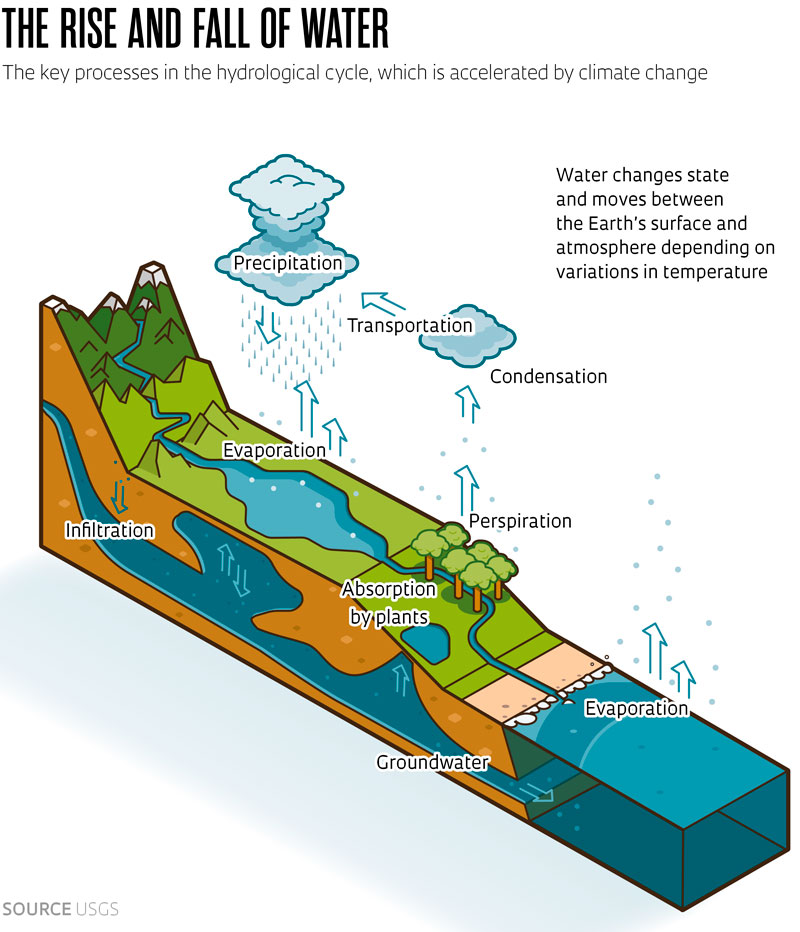Three-quarters of our planet is covered in water. The famous H₂O molecule, vital to life on Earth, constantly changes state and location depending on variations in temperature. It transforms from a vapor in the atmosphere to a liquid or solid on the Earth’s surface (in soils, rivers, lakes, and oceans), and vice versa. Water does all this without leaving Earth. Its quantity is virtually constant. The main processes involved in this cycle are evaporation, plant transpiration, condensation, precipitation (rain and snow), and surface runoff (see graphic). In recent decades, global warming has accelerated the water cycle, especially the evapotranspiration phase (evaporation and plant transpiration), which can result in both more rainfall and more droughts.
It might seem like more water vapor — the invisible gas that fuels rain clouds — in the air would be ideal for generating more rainfall, and sometimes this is true. However, the oppo — site can be equally true, especially in tropical regions. “Warming of the atmosphere is a double-edged sword,” says Gilvan Sampaio, a meteorologist from Brazil’s National Institute for Space Research (INPE). “It can generate heavy, concentrated rainfall, but also prolonged droughts.”
The explanation lies in a thermodynamic relation: the hotter the air, the more water vapor is needed for clouds and rain to form. At the end of the dry season in the southern Amazon, for example, there can be less rainfall due to limited evapotranspiration from deforested areas. This tends to slightly delay the start of the rainy season.
Rain clouds only form when the atmosphere reaches saturation point (100% relative humidity), meaning the air is carrying the maximum amount of water vapor that it can retain at a given temperature. Once this saturation point is reached, the water vapor condenses and becomes liquid. These water droplets then form rain clouds and fog. The problem is that the rise in temperatures both regionally and globally — last year was the hottest on record in Brazil and worldwide — makes it exponentially difficult for the air to reach the saturation point.
Every rise by one degree Celsius (°C) increases the atmosphere’s capacity to retain water vapor without condensation occurring by approximately 7%, according to the Clausius-Clapeyron relation. At 25 °C, the same volume of air can store almost three times more water vapor than at 10 °C, and 50% more than at 20 °C. This explains why it tends to rain at the end of a hot summer’s day in areas with a large volume of surface water. A lot of water evaporates throughout the day due to the heat. When the temperature finally drops, the air saturation point also drops, causing rain clouds to form. The air can no longer retain the same amount of moisture as it was capable of holding when the temperature was higher. To restore thermal equilibrium, rainfall occurs. Global warming also has other impacts on the hydrological cycle. When sea temperatures exceed 27 °C, evaporation increases exponentially. Much of this water vapor moves over land, where it can generate heavy rain.
Since the preindustrial period in the second half of the nineteenth century, the average global temperature has increased by just over 1.1 °C. But there are places in the world — and in Brazil, such as the southern Amazon and the interior of the Northeast — where local temperatures have risen by 2 to 3 °C in recent decades.
Global warming is not the only factor influencing the occurrence of rainfall. “Air humidity and regional changes in surface water coverage can have an impact on the hydrological cycle, such as the heat island effect in densely urbanized areas and the conversion of forest vegetation to agriculture,” points out Humberto Ribeiro da Rocha, a hydroclimatology expert from the Institute of Astronomy, Geophysics, and Atmospheric Sciences at the University of São Paulo (IAG-USP).
Climate change will cause more concentrated rainfall and prolonged droughts
Rainfall is such a complex phenomenon that estimating when, where, and how much it will rain is always a challenge, even though current short- and medium-term forecasts are increasingly accurate. Changes in wind patterns or geographic obstacles can cause water vapor generated in one location, or at least some of it, to produce rain somewhere else very far away. The amount of green vegetation in an area is a critical data point in the hydrological cycle.
It is no coincidence that the Amazon is known as a rainforest. In its best-preserved areas, where the forest is dense and enclosed, it is less hot and rains more often, with precipitation spread relatively evenly across the year. In deforested and degraded regions, such as the south and east, temperatures are higher (2 ºC or 3 ºC above preserved areas of the forest) and the dry period is becoming longer and longer.
“Evapotranspiration is about three times lower in a deforested area occupied by pasture than in a preserved part of the rainforest,” says climatologist Carlos Nobre of USP’s Institute of Advanced Studies (IEA). For years, the researcher’s work has warned about the climate and environmental risks posed by savannization of the tropical forest. As well as generating its own rainfall, the Amazon also provides water vapor to other parts of South America. Deforestation (around 20% has already been cut down) is therefore a sure bet in the drought futures market.
Project
Center for Water and Food Security in Critical Zones (nº 21/11762-5); Grant Mechanism Research Grant – Science for Development Centers; Principal Investigator Humberto Ribeiro da Rocha (USP); Investment R$5,424,799.06.
Republish
